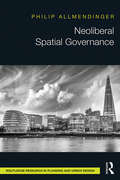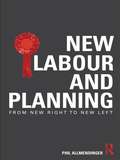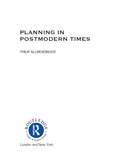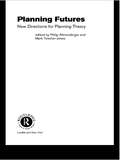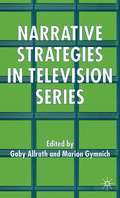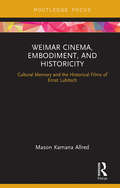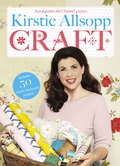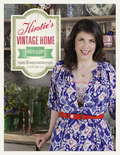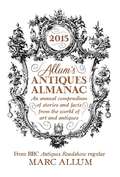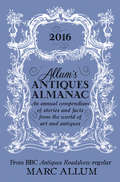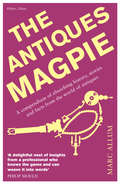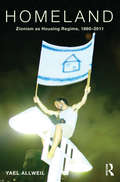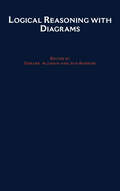- Table View
- List View
Neoliberal Spatial Governance
by Phil AllmendingerNeoliberal Spatial Governance explores the changing nature of English town and city planning as it has slowly but clearly transformed. Once a system for regulating and balancing change in the built and natural environments in the public interest, planning now finds itself facilitating development and economic growth for narrow, sectional interests. Whilst there is a lip service towards traditional values, the progressive aims and inclusivity that provided planning’s legitimacy and broad support have now largely disappeared. The result is a growing backlash of distrust and discontent as planning has evolved into neoliberal spatial governance. The tragedy of this change is that at a time when planning has a critical role in tackling major issues such as housing affordability and climate change, it finds itself poorly resourced with low professional morale, lacking legitimacy and support from local communities, accused of bureaucracy and ‘red tape’ from businesses and ministers and subject to regular, disruptive reforms. Yet all is not lost. There is still demand and support for more comprehensive and progressive planning, one that is not purely driven by the needs of developers and investors. Resistance against the idea that planning exists to help roll out development, is growing. Neoliberal Spatial Governance explores the background and implications of the changes in planning under the governments of the past four decades and the ways we might think about halting and reversing this shift.
New Labour and Planning: From New Right to New Left
by Phil AllmendingerFollowing the Thatcher and Major administrations there was an apparent renaissance of planning under New Labour. After a slow start in which Labour’s view of planning owed more to a neo-liberal, rolled back state model reminiscent of the New Right the Government began to appreciate that many of its wider objectives including economic development, climate change, democratic renewal, social justice and housing affordability intersected with and were critically dependent upon the planning system. A wide range of initiatives, management processes, governance vehicles and policy documents emanated from Government. Planning, like other areas of the public sector, was to be reformed and modernised as well as given a prime role in tackling national, high profile priorities such as increasing housing supply and improving economic competitiveness. Drawing upon an institutionalist framework the book also seeks to understand how and in what circumstances change emerges, either in an evolutionary or punctuated way. It will, for the first time, chart and explore the changing nature of development and planning over the Labour era whilst also stepping back and reflecting upon what such changes mean for planning generally and the likely future trajectories of reform and spatial governance.
New Labour and Planning: From New Right to New Left
by Phil AllmendingerFollowing the Thatcher and Major administrations there was an apparent renaissance of planning under New Labour. After a slow start in which Labour’s view of planning owed more to a neo-liberal, rolled back state model reminiscent of the New Right the Government began to appreciate that many of its wider objectives including economic development, climate change, democratic renewal, social justice and housing affordability intersected with and were critically dependent upon the planning system. A wide range of initiatives, management processes, governance vehicles and policy documents emanated from Government. Planning, like other areas of the public sector, was to be reformed and modernised as well as given a prime role in tackling national, high profile priorities such as increasing housing supply and improving economic competitiveness. Drawing upon an institutionalist framework the book also seeks to understand how and in what circumstances change emerges, either in an evolutionary or punctuated way. It will, for the first time, chart and explore the changing nature of development and planning over the Labour era whilst also stepping back and reflecting upon what such changes mean for planning generally and the likely future trajectories of reform and spatial governance.
Planning in Postmodern Times (RTPI Library Series)
by Philip AllmendingerPostmodern social theory has provided significant insights into our understanding of society and its components. Key thinkers including Foucault, Baudrillard and Lyotard have challenged existing ideas about power and rationality in society. This book analyses planning from a postmodern perspective and explores alternative conceptions based on a combination of postmodern thinking and other fields of social theory. In doing so, it exposes some of the limits of postmodern social theory while providing an alternative conception of planning in the twenty-first century.This title will appeal to anyone interested in how we think and act in relation to cities, urban planning and governance.
Planning in Postmodern Times (RTPI Library Series)
by Philip AllmendingerPostmodern social theory has provided significant insights into our understanding of society and its components. Key thinkers including Foucault, Baudrillard and Lyotard have challenged existing ideas about power and rationality in society. This book analyses planning from a postmodern perspective and explores alternative conceptions based on a combination of postmodern thinking and other fields of social theory. In doing so, it exposes some of the limits of postmodern social theory while providing an alternative conception of planning in the twenty-first century.This title will appeal to anyone interested in how we think and act in relation to cities, urban planning and governance.
Planning Futures: New Directions for Planning Theory
by Philip Allmendinger Mark Tewdwr-JonePlanning theory is currently in a confused state as a consequence of a number of changes over the last ten years in planning practice and social and economic theory. Even prior to these events, planning theory was an uncertain discipline, reflecting planning's precarious position between and resting upon a range of professional subject areas and philosophical roots. Planning Futures is an attempt to pin down the constantly evolving landscape of planning theory and to chart a path through this fast changing field.Planning Futures is an up-to-date reader on planning theory, but adds something more to the subject area than a mere textbook. The contributors have attempted to bridge theory and practice while putting forward new theoretical ideas. By drawing upon examples from planning practice and case study scenarios, the authors ensure that the work discusses planning theory within the context of present planning practice. Case studies are drawn from an international arena, from the UK, Europe, South Africa and Australia.
Planning Futures: New Directions for Planning Theory
by Philip Allmendinger Mark Tewdwr-JonesPlanning theory is currently in a confused state as a consequence of a number of changes over the last ten years in planning practice and social and economic theory. Even prior to these events, planning theory was an uncertain discipline, reflecting planning's precarious position between and resting upon a range of professional subject areas and philosophical roots. Planning Futures is an attempt to pin down the constantly evolving landscape of planning theory and to chart a path through this fast changing field.Planning Futures is an up-to-date reader on planning theory, but adds something more to the subject area than a mere textbook. The contributors have attempted to bridge theory and practice while putting forward new theoretical ideas. By drawing upon examples from planning practice and case study scenarios, the authors ensure that the work discusses planning theory within the context of present planning practice. Case studies are drawn from an international arena, from the UK, Europe, South Africa and Australia.
The traumatic surreal: Germanophone women artists and Surrealism after the Second World War
by Patricia AllmerThe traumatic surreal is the first major study to examine the ground-breaking role played by Germanophone women artists working in surrealist traditions in responding to the traumatic events and legacies of the Second World War. Analysing works in a variety of media by leading artists and writers, the book redefines the post-war trajectories of surrealism and recalibrates critical understandings of the movement’s relations to historical trauma. Chapters address artworks, writings and compositions by the Swiss Meret Oppenheim, the German Unica Zürn, the Austrian Birgit Jürgenssen, the Luxembourg-Austrian Bady Minck and the Austrian Olga Neuwirth and her collaboration with fellow Austrian Nobel-prize winning novelist Elfriede Jelinek. Locating each artist in their historical context, the book traces the development of the traumatic surreal through the wartime and post-war period.
The traumatic surreal: Germanophone women artists and Surrealism after the Second World War
by Patricia AllmerThe traumatic surreal is the first major study to examine the ground-breaking role played by Germanophone women artists working in surrealist traditions in responding to the traumatic events and legacies of the Second World War. Analysing works in a variety of media by leading artists and writers, the book redefines the post-war trajectories of surrealism and recalibrates critical understandings of the movement’s relations to historical trauma. Chapters address artworks, writings and compositions by the Swiss Meret Oppenheim, the German Unica Zürn, the Austrian Birgit Jürgenssen, the Luxembourg-Austrian Bady Minck and the Austrian Olga Neuwirth and her collaboration with fellow Austrian Nobel-prize winning novelist Elfriede Jelinek. Locating each artist in their historical context, the book traces the development of the traumatic surreal through the wartime and post-war period.
Videocracy: How YouTube Is Changing the World . . . with Double Rainbows, Singing Foxes, and Other Trends We Can’t Stop Watching
by Kevin AlloccaFrom YouTube's Head of Culture and Trends, a rousing and illuminating behind-the-scenes exploration of internet video's massive impact on our world.Whether your favorite YouTube video is a cat on a Roomba, “Gangnam Style,” the “Bed Intruder” song, an ASAPscience explainer, Rebecca Black's “Friday,” or the “Evolution of Dance,” Kevin Allocca's Videocracy reveals how these beloved videos and famous trends--and many more--came to be and why they mean more than you might think. YouTube is the biggest pool of cultural data since the beginning of recorded communication, with four hundred hours of video uploaded every minute. (It would take you more than sixty-five years just to watch the vlogs, music videos, tutorials, and other content posted in a single day!) This activity reflects who we are, in all our glory and ignominy. As Allocca says, if aliens wanted to understand our planet, he'd give them Google. If they wanted to understand us, he'd give them YouTube. In Videocracy, Allocca lays bare what YouTube videos say about our society and how our actions online--watching, sharing, commenting on, and remixing the people and clips that captivate us--are changing the face of entertainment, advertising, politics, and more. Via YouTube, we are fueling social movements, enforcing human rights, and redefining art--a lot more than you'd expect from a bunch of viral clips.
Videocracy: How YouTube Is Changing the World . . . with Double Rainbows, Singing Foxes, and Other Trends We Can’t Stop Watching
by Kevin AlloccaFrom YouTube's Head of Culture and Trends, a rousing and illuminating behind-the-scenes exploration of internet video's massive impact on our world.Whether your favorite YouTube video is a cat on a Roomba, “Gangnam Style,” the “Bed Intruder” song, an ASAPscience explainer, Rebecca Black's “Friday,” or the “Evolution of Dance,” Kevin Allocca's Videocracy reveals how these beloved videos and famous trends--and many more--came to be and why they mean more than you might think. YouTube is the biggest pool of cultural data since the beginning of recorded communication, with four hundred hours of video uploaded every minute. (It would take you more than sixty-five years just to watch the vlogs, music videos, tutorials, and other content posted in a single day!) This activity reflects who we are, in all our glory and ignominy. As Allocca says, if aliens wanted to understand our planet, he'd give them Google. If they wanted to understand us, he'd give them YouTube. In Videocracy, Allocca lays bare what YouTube videos say about our society and how our actions online--watching, sharing, commenting on, and remixing the people and clips that captivate us--are changing the face of entertainment, advertising, politics, and more. Via YouTube, we are fueling social movements, enforcing human rights, and redefining art--a lot more than you'd expect from a bunch of viral clips.
Imagining the Present: Context, Content, and the Role of the Critic (Critical Voices in Art, Theory and Culture)
by Lawrence AllowayBringing together twenty-nine of Lawrence Alloway’s most influential essays in one volume, this fascinating collection provides valuable perspectives on the art and visual culture of the second half of the twentieth century. Lawrence Alloway ranks among the most important critics of his time, and his contributions to the spirited and contentious dialogue of his era make for fascinating reading. These twenty-nine provocative essays from 1956 to 1980 from the man who invented the term ‘pop art’ bring art, film, iconography, cybernetics and culture together for analysis and investigation, and do indeed examine the context, content and role of the critic in art and visual culture. Featuring a critical commentary by Richard Kalina, and preface by series editor Saul Ostrow, Imagining the Present will be an enthralling read for all art and visual culture students.
Narrative Strategies in Television Series
by G. Allrath M. GymnichIn the context of a systematic overview of the possibilities of applying narratological concepts to a study of TV series, ten case studies are explored in depth, demonstrating how series such as 24, Buffy, Twin Peaks, Star Trek, Blackadder, and Sex and the City make use of innovative audiovisual means of storytelling. Transgressing the traditional confines of narrative theory, the chapter authors address the question of how form, content, and function intersect in these series.
Weimar Cinema, Embodiment, and Historicity: Cultural Memory and the Historical Films of Ernst Lubitsch (Routledge Focus on Film Studies)
by Mason Kamana AllredIn its retrieval and (re)construction, the past has become interwoven with the images and structure of cinema. Not only have mass media—especially film and television—shaped the content of memories and histories, but they have also shaped their very form. Combining historicization with close readings of German director Ernst Lubitsch's historical films, this book focuses on an early turning point in this development, exploring how the medium of film shaped modern historical experience and understanding—how it moved embodied audiences through moving images.
Weimar Cinema, Embodiment, and Historicity: Cultural Memory and the Historical Films of Ernst Lubitsch (Routledge Focus on Film Studies)
by Mason Kamana AllredIn its retrieval and (re)construction, the past has become interwoven with the images and structure of cinema. Not only have mass media—especially film and television—shaped the content of memories and histories, but they have also shaped their very form. Combining historicization with close readings of German director Ernst Lubitsch's historical films, this book focuses on an early turning point in this development, exploring how the medium of film shaped modern historical experience and understanding—how it moved embodied audiences through moving images.
Kirstie Allsopp Craft
by Kirstie Allsopp'To my utter joy, crafts of every kind have made their way back into our lives - big style. They've shaken off their old-fashioned image and a whole new generation of people have embraced them. Join me on my voyage of discovery, meeting passionate crafters, learning the secrets of their amazing artistry and then, for my sins, trying to compete with them in craft competitions across the country.' Kirstie Allsopp Kirstie Allsopp's love affair with British crafts took off when she renovated her house in Devon. Now she takes to the road on a tour of the country to discover and celebrate the things that make Great Britain a nation of truly great crafters. Kirstie Allsopp Craft is an inspiring collection of projects that introduces you to traditional crafting skills in a fresh, modern way. From making your own family scrapbooks and appliqué cushions to jam-making and handmade bunting, Kirstie Allsopp Craft contains 50 practical projects to inspire you to have a go.
Kirstie's Homemade Home
by Kirstie Allsopp'This book is packed with achievable ways to transform your house into a home that reflects you and the things you value, plus lots of gorgeous craft projects to try yourself. Welcome to my world.' Kirstie Allsopp Be inspired to create a home that reflects you and the things that you love with the help of Kirstie's Homemade Home. Nothing compares with the pleasure and satisfaction of making something yourself and Kirstie shows just how easy it can be. Drawing on the advice and enthusiasm of a host of craft experts, Kirstie shows how to personalise your home and create your own gifts with simple and practical step-by-step projects. From stencilling wallpaper and sewing your own cushions and quilts, to making candles and soap and icing a cake, Kirstie's Homemade Home includes everything you need to get to get you started. Packed with advice on how to find a style that reflects you as well as Kirstie's own little black book of shops and websites that have helped her to transform her own home, Kirstie's Homemade Home is for everyone who loves car boot sales and antiques and values the art of the homemade.
Kirstie's Vintage Home: Includes 30 Simple Handmade Projects
by Kirstie AllsoppTransform your home from shabby to chic, with the help of Kirstie Allsopp. Looking to the past for inspiration and embracing vintage style to create something unique and beautiful, Kirstie continues her love affair with everything handmade.Re-using, restoring and upcycling, Kirstie shows how to transform vintage fabrics, furniture and other everyday things into modern day treasures using a range of crafting skills and techniques.From distressing a mirror and decoupage to making a memory quilt with vintage fabric, the book is packed with practical techniques that can be adapted to suit your own objects and furniture.Accompanying a new Channel 4 series, Kirstie's Vintage Home contains everything you need to create your own vintage look at home.
Allum's Antiques Almanac 2015: An Annual Compendium of Stories and Facts From the World of Art and Antiques
by Marc AllumFrom the BBC Antiques Roadshow specialist and author who brought you The Antiques Magpie comes the first annual almanac keeping you bang up to date with the vibrant, pacey and often amusingly idiosyncratic global art and antiques market. Find out: * How much the wedding ring of Lee Harvey Oswald sold for * What the world’s most expensive printed book cost per word * Which First World War artefacts have enthused collectors amid the centenary commemorations ...and much more Written with Marc’s trademark blend of knowledge, enthusiasm, irreverence and wit, Allum’s Antiques Almanac 2015 provides a unique insight into a boundless world fuelled by history, avarice and passion, making it a must-read for the inherent collector in all of us.
Allum's Antiques Almanac 2016: An Annual Compendium of Stories and Facts From the World of Art and Antiques
by Marc AllumFrom BBC Antiques Roadshow specialist and author Marc Allum comes the second instalment of his annual almanac, revealing the current news, tall tales and tasty titbits from the year in art, antiques and collectables: What do London Bridge and a £40,000 corkscrew have in common? Which famous pop star depicted by Andy Warhol realised £51.6 million at a recent auction? How much did Oliver Cromwell’s coffin plate sell for, and what happened to his famous wart? Which Hollywood film led to the recovery of a Hungarian avant garde masterpiece? What would a collector pay for the real Batmobile? Why did a tiny portrait of Mozart - only four centimetres high - sell for £218,500? Answers to these and many other fascinating questions make this the essential guide this autumn for all ardent fans of art, antiques and collectables.
The Antiques Magpie: A compendium of absorbing history, stories and facts from the world of antiques (Magpie Ser.)
by Marc AllumFrom the mythical artefacts of the ancient world to saucy seaside postcards, The Antiques Magpie explores the wonderful world of antiques and collectables. With Antiques Roadshow regular Marc Allum as your guide, go in search of stolen masterpieces, explore the first museums, learn the secrets of the forgers and brush up on your auction technique. Meet the garden gnome insured for £1 million, track down Napoleon’s toothbrush, find out how to spot a corpse in a Victorian photograph – and much more. This book is for anyone who’s ever been fascinated by what relics of the past tell us about history – and what they are worth today.
The Collector's Cabinet: Tales, Facts and Fictions from the World of Antiques
by Marc AllumExplore the wonderful world of antiques and collectables with Antiques Roadshow regular, Marc Allum. Go in search of stolen masterpieces, learn the secrets of the forgers, track down Napoleon’s toothbrush and meet the garden gnome insured for £1 million. Eclectic, eccentric and brimming with remarkable tales from history, The Collector’s Cabinet is for all those who are fascinated by the relics of the past.
Homeland: Zionism as Housing Regime, 1860–2011 (Planning, History and Environment Series)
by Yael AllweilOn 29 March 2016 the New York based online journal, Realty Today reported ‘Israel is facing a housing crisis with …[the] home inventory lacking 100,000 apartments… House prices, which have more than doubled in less than a decade, resulted in a mass protest back in 2011’. As Yael Allweil reveals in her fascinating book, housing has played a pivotal role in the history of nationalism and nation building in Israel-Palestine. She adopts the concept of ‘homeland’ to highlight how land and housing are central to both Zionism and Palestinian nationalism, and how the history of Zionist and Palestinian national housing have been inseparably intertwined from the introduction of the Ottoman Land Code in 1858 to the present day. Following the Introduction, Part I, ‘Historiographies of Land Reform and Nationalism’, discusses the formation of nationalism as the direct result of the Ottoman land code of 1858. Part II, ‘Housing as Proto-Nationalism’ focuses on housing as the means to claim rights over the homeland. Part III, ‘Housing and Nation-Building in the Age of State Sovereignty’, explores the effects of statehood on national housing across several strata of Israeli society. The Afterword discusses housing as the quintessential object of agonistic conflict in Israel-Palestine, around which the Israeli polity is formed and reformed.
Homeland: Zionism as Housing Regime, 1860–2011 (Planning, History and Environment Series)
by Yael AllweilOn 29 March 2016 the New York based online journal, Realty Today reported ‘Israel is facing a housing crisis with …[the] home inventory lacking 100,000 apartments… House prices, which have more than doubled in less than a decade, resulted in a mass protest back in 2011’. As Yael Allweil reveals in her fascinating book, housing has played a pivotal role in the history of nationalism and nation building in Israel-Palestine. She adopts the concept of ‘homeland’ to highlight how land and housing are central to both Zionism and Palestinian nationalism, and how the history of Zionist and Palestinian national housing have been inseparably intertwined from the introduction of the Ottoman Land Code in 1858 to the present day. Following the Introduction, Part I, ‘Historiographies of Land Reform and Nationalism’, discusses the formation of nationalism as the direct result of the Ottoman land code of 1858. Part II, ‘Housing as Proto-Nationalism’ focuses on housing as the means to claim rights over the homeland. Part III, ‘Housing and Nation-Building in the Age of State Sovereignty’, explores the effects of statehood on national housing across several strata of Israeli society. The Afterword discusses housing as the quintessential object of agonistic conflict in Israel-Palestine, around which the Israeli polity is formed and reformed.
Logical Reasoning with Diagrams (Studies in Logic and Computation)
by Gerard Allwein Jon BarwiseOne effect of information technology is the increasing need to present information visually. The trend raises intriguing questions. What is the logical status of reasoning that employs visualization? What are the cognitive advantages and pitfalls of this reasoning? What kinds of tools can be developed to aid in the use of visual representation? This newest volume on the Studies in Logic and Computation series addresses the logical aspects of the visualization of information. The authors of these specially commissioned papers explore the properties of diagrams, charts, and maps, and their use in problem solving and teaching basic reasoning skills. As computers make visual representations more commonplace, it is important for professionals, researchers and students in computer science, philosophy, and logic to develop an understanding of these tools; this book can clarify the relationship between visuals and information.
